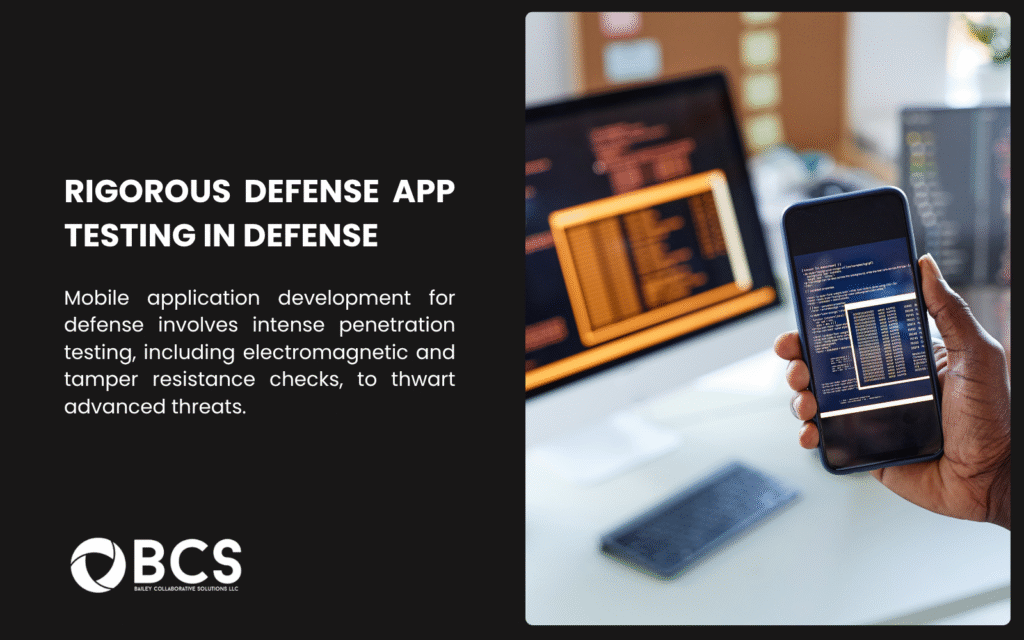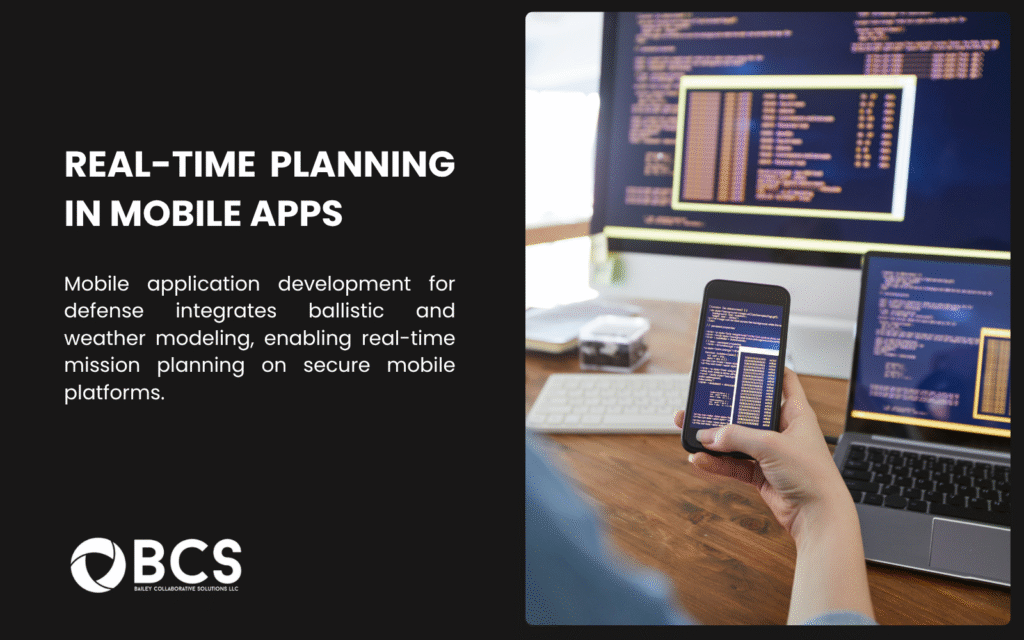Technical Executive Summary
Mobile application development in defense and aerospace sectors demands specialized approaches that transcend conventional commercial methodologies. Contemporary defense contractors face complex technical requirements encompassing secure communications, real-time telemetry processing, and mission-critical operational interfaces.
The evolving landscape of mobile application development necessitates robust architectural frameworks capable of supporting classified data handling, electromagnetic interference resistance, and multi-domain operational environments.
Defense-grade mobile applications require stringent security protocols, including hardware-based encryption, biometric authentication systems, and air-gapped deployment capabilities.
These applications must function across diverse platforms while maintaining interoperability with legacy defense systems and emerging space-based communication networks. The technical complexity involves distributed computing architectures, edge processing capabilities, and resilient data synchronization mechanisms designed for intermittent connectivity scenarios.
Current mobile application development practices for defense applications incorporate model-based systems engineering principles, continuous integration pipelines with security validation, and automated testing frameworks specifically calibrated for mission-critical environments. The technical implementation spans multiple abstraction layers, from low-level hardware abstraction to high-level mission planning interfaces, requiring specialized expertise in both mobile computing paradigms and defense system architectures.

Key Technical Findings and Recommendations
Defense contractors must prioritize security-first architectural design patterns when developing mobile applications for government clients. The technical implementation should incorporate zero-trust security models, hardware security modules, and compartmentalized data access controls. These applications require specialized development environments that support classified information processing while maintaining operational efficiency across diverse deployment scenarios.
| Technical Implementation Priority | Defense Application Requirement | Commercial Standard Gap |
| Hardware Security Integration | Mandatory HSM/TPM Support | Optional Implementation |
| Electromagnetic Hardening | MIL-STD-461 Compliance | No Requirement |
| Cryptographic Standards | FIPS 140-2 Level 3/4 | Basic SSL/TLS |
| Operational Continuity | 99.99% Uptime SLA | 99.9% Standard |
| Data Classification Handling | Multi-level Security Controls | Single-tier Access |
Defense-Specific Mobile Application Architecture
Defense mobile application development requires specialized architectural patterns that address unique operational constraints. The technical foundation must support classified data processing, real-time command and control interfaces, and seamless integration with existing defense infrastructure. These systems operate within highly regulated environments where security, reliability, and performance specifications exceed commercial standards by significant margins.
The architectural approach incorporates multiple security domains within single application frameworks, enabling compartmentalized access to different classification levels while maintaining operational efficiency. Technical implementation involves specialized middleware layers that handle secure communications, data sanitization, and cross-domain solution integration. These applications must function across diverse network topologies, from secure military networks to commercial internet infrastructure, while maintaining consistent security postures.
Modern defense mobile applications leverage containerized deployment models with specialized runtime environments designed for classified processing. The technical stack includes hardened operating systems, secure communication protocols, and specialized debugging tools that operate within classified environments. Development teams must possess security clearances and specialized training in defense system architectures.
| Architecture Component | Defense Specification | Technical Implementation |
| Security Domain Separation | Multi-Level Security (MLS) | Compartmentalized Virtual Machines |
| Communication Protocols | HAIPE/COMSEC Integration | Hardware-Based Encryption |
| Data Storage | Classified Information Handling | Encrypted Database Clusters |
| User Authentication | CAC/PIV Card Integration | Hardware Token Validation |
| Network Topology | SIPR/NIPR Compatibility | Cross-Domain Solutions |
Mobile Application Penetration Testing for Defense Systems
Defense mobile applications undergo rigorous penetration testing procedures that exceed commercial security assessment standards. The testing methodology encompasses both automated vulnerability scanning and manual exploitation techniques specifically designed for defense system architectures. These assessments evaluate application security across multiple threat vectors, including nation-state adversaries, insider threats, and sophisticated persistent threats targeting critical infrastructure.
Technical penetration testing for defense mobile applications involves specialized tools and methodologies approved for use within classified environments. The testing process includes source code analysis, binary reverse engineering, and runtime exploitation attempts conducted within controlled laboratory environments. Security researchers must possess appropriate clearances and undergo specialized training in defense system vulnerabilities and threat modeling.
The penetration testing framework incorporates both traditional mobile application security testing and defense-specific assessments such as electromagnetic emanation analysis, side-channel attack resistance, and tamper evidence validation. Testing teams evaluate application behavior under various operational stress conditions, including degraded network connectivity, hostile electromagnetic environments, and potential physical compromise scenarios.
| Penetration Testing Domain | Defense Requirement | Testing Methodology |
| Source Code Security | Static Analysis with Classified Tools | Manual Code Review + Automated Scanning |
| Runtime Exploitation | Dynamic Testing in Controlled Environment | Penetration Testing in Isolated Networks |
| Hardware Security | Physical Tampering Resistance | Laboratory-Based Physical Testing |
| Electromagnetic Security | TEMPEST Compliance Validation | RF Emanation Analysis |
| Network Security | Multi-Domain Communication Testing | Cross-Domain Solution Validation |
Cost Analysis Framework for Defense Mobile Applications
Mobile application development cost structures for defense contractors differ significantly from commercial development models due to specialized security requirements, clearance restrictions, and compliance obligations. The financial framework encompasses development, testing, certification, and maintenance phases, each requiring specialized resources and extended timelines compared to commercial applications.
Defense mobile application development costs include specialized security testing, certification processes, and ongoing compliance monitoring that can increase total project costs by 300-500% compared to equivalent commercial applications. The cost structure reflects the need for cleared personnel, specialized development environments, and extensive documentation requirements mandated by defense acquisition regulations.

Long-term maintenance costs for defense mobile applications include periodic security updates, compliance audits, and technology refresh cycles aligned with defense system lifecycles. These applications often require support for extended periods, sometimes decades, necessitating specialized maintenance contracts and technology obsolescence management strategies.
| Cost Component | Defense Project Multiplier | Commercial Baseline | Technical Justification |
| Development Personnel | 2.5x – 3.5x | Standard Developer Rates | Clearance Premiums + Specialized Skills |
| Security Testing | 4x – 6x | Standard QA Testing | Penetration Testing + Certification |
| Compliance Documentation | 3x – 5x | Minimal Documentation | Defense Acquisition Requirements |
| Maintenance & Support | 2x – 4x | Standard Support Contracts | Extended Lifecycle + Security Updates |
| Infrastructure Costs | 3x – 7x | Commercial Cloud Services | Classified Computing Environments |
Advanced Modeling and Simulation Integration
Contemporary defense mobile applications increasingly incorporate advanced modeling and simulation capabilities that enable real-time operational planning and mission rehearsal. These applications leverage computational fluid dynamics, electromagnetic propagation models, and ballistic trajectory calculations directly within mobile interfaces, providing commanders with sophisticated analytical capabilities in field environments.
The technical implementation of advanced modeling within mobile applications requires specialized computational architectures capable of executing complex simulations on resource-constrained platforms. Development teams must balance computational accuracy with performance constraints while maintaining real-time responsiveness for mission-critical operations. These applications often incorporate machine learning models trained on classified datasets, requiring specialized deployment and update mechanisms.
Integration with digital engineering tools becomes essential when mobile applications must interface with comprehensive simulation environments used in defense system development. The mobile applications serve as front-end interfaces to complex modeling systems, providing simplified user interactions while maintaining access to sophisticated analytical capabilities developed through model-based systems engineering methodologies.
| Simulation Capability | Mobile Implementation | Technical Constraint |
| Ballistic Trajectory Modeling | Real-time Calculation Engines | Battery Life + Processing Power |
| Electromagnetic Propagation | Simplified Physics Models | Memory Limitations |
| Weather Impact Analysis | Cloud-Based Processing | Network Connectivity |
| Terrain Analysis | Offline Geographic Databases | Storage Capacity |
| Mission Planning | Distributed Computing Architecture | Security Boundaries |
Security Architecture and Implementation
Defense mobile application development prioritizes security architecture that addresses both traditional cybersecurity threats and specialized military operational security requirements. The security framework encompasses multiple layers, from hardware-based root of trust implementations to application-level access controls designed for multi-classification environments.
Technical security implementation requires specialized cryptographic libraries certified for government use, hardware security modules integrated into mobile platforms, and secure communication protocols designed for military networks. The architecture must support both online and offline operational modes while maintaining equivalent security postures across different connectivity scenarios.
Modern defense mobile applications implement zero-trust security models that continuously validate user identity, device integrity, and network security posture. The technical implementation includes continuous device health monitoring, behavioral analysis systems, and automated threat response capabilities designed to operate within classified network environments.
| Security Layer | Implementation Approach | Technical Standard |
| Hardware Root of Trust | TPM/HSM Integration | FIPS 140-2 Level 3+ |
| Operating System Security | Hardened Mobile OS | Common Criteria EAL4+ |
| Application Security | Code Signing + Sandboxing | DoD Software Security |
| Network Security | VPN + Certificate-Based Auth | Suite B Cryptography |
| Data Protection | End-to-End Encryption | NSA-Approved Algorithms |
System Development Life Cycle Integration
Defense mobile application development must align with established system development life cycle methodologies used throughout defense acquisition programs. The development process incorporates multiple phases of requirements analysis, design verification, implementation validation, and operational testing that extend beyond traditional commercial software development timelines.

The technical approach requires integration with existing defense system architectures and alignment with 7 stages of system development life cycle frameworks established for defense programs. Mobile application development becomes a component within larger system engineering efforts, requiring careful coordination with hardware development, network infrastructure, and operational procedures.
Defense contractors must demonstrate compliance with software development life cycle requirements that include extensive documentation, traceability matrices, and verification procedures designed to support system certification processes. The mobile application development process must accommodate multiple stakeholder reviews, security assessments, and operational testing phases.
| SDLC Phase | Defense Mobile Application Requirement | Technical Deliverable |
| Requirements Analysis | Mission Need Statement Alignment | Technical Requirements Document |
| System Design | Architecture Compliance Review | Security Architecture Document |
| Implementation | Secure Coding Standards | Source Code + Security Analysis |
| Integration Testing | System-Level Validation | Test Results + Certification Evidence |
| Operational Testing | User Acceptance in Operational Environment | Operational Test Report |
| Deployment | Security Certification Process | Authority to Operate (ATO) |
Platform-Specific Development Considerations
Defense mobile application development must address unique platform requirements across diverse mobile operating systems while maintaining consistent security postures and operational capabilities. The technical implementation challenges include supporting legacy hardware platforms, accommodating specialized military communication devices, and maintaining interoperability across different military branches with varying technology standards.
Technical development teams must navigate platform-specific security implementations, each requiring different approaches to hardware security integration, secure boot processes, and application sandboxing mechanisms. The development process must accommodate both commercial mobile platforms modified for government use and specialized military mobile computing devices designed specifically for defense applications.
Cross-platform development strategies for defense applications require specialized frameworks that support security requirements across different operating systems while maintaining code reusability and development efficiency. The technical approach must balance platform-specific optimization with the need for consistent functionality across diverse deployment environments.
| Platform Category | Security Implementation | Development Approach |
| Commercial iOS (Modified) | Hardware Security + App Store Alternatives | Native Development + Custom Provisioning |
| Commercial Android (Hardened) | KNOX Integration + Custom ROMs | Native Development + Security Frameworks |
| Military-Specific Devices | Specialized OS + Hardware Integration | Custom Development Environments |
| Ruggedized Tablets | Extended Temperature + EMI Resistance | Hardware Abstraction Layer |
| Wearable Devices | Power Optimization + Secure Communications | Embedded Systems Development |
Testing and Validation Methodologies
Defense mobile application testing extends beyond traditional software quality assurance to include specialized validation procedures designed for mission-critical environments. The testing framework encompasses functional verification, security validation, performance analysis under stress conditions, and interoperability testing with existing defense systems.
Technical testing procedures include specialized environments that simulate operational conditions such as electromagnetic interference, extreme temperatures, shock and vibration exposure, and intermittent network connectivity. Testing teams must validate application behavior across diverse operational scenarios while maintaining security postures and performance requirements.
The validation process incorporates both automated testing frameworks and manual verification procedures conducted by personnel with operational experience in defense systems. Testing methodologies must accommodate classified data handling requirements and specialized security testing tools approved for use within defense environments.
| Testing Category | Defense Requirement | Technical Implementation |
| Functional Testing | Mission-Critical Operation Validation | Automated Test Suites + Manual Verification |
| Security Testing | Vulnerability Assessment + Penetration Testing | Specialized Security Tools + Expert Analysis |
| Performance Testing | Stress Testing Under Operational Conditions | Load Generation + Resource Monitoring |
| Interoperability Testing | Legacy System Integration Validation | Protocol Testing + Interface Verification |
| Environmental Testing | Military Standard Compliance | Laboratory Testing + Field Validation |
Implementation Strategy and Technical Architecture
Successful defense mobile application development requires strategic technical architecture decisions that balance operational requirements with implementation constraints. The architectural approach must accommodate both current operational needs and future technology evolution while maintaining security and performance standards throughout extended operational lifecycles.
Technical implementation strategies should leverage digital platform engineering principles that enable scalable, maintainable applications capable of supporting multiple mission domains. The architecture must support both standalone operation and integration with larger defense system ecosystems through standardized interfaces and communication protocols.
The implementation approach benefits from digital product engineering methodologies that emphasize user-centered design within security-constrained environments. Development teams must balance sophisticated technical capabilities with intuitive user interfaces designed for high-stress operational environments where user error can have significant consequences.
Modern defense mobile applications increasingly incorporate elements of digital quality engineering that ensure consistent performance across diverse operational conditions. The quality framework must address both traditional software quality metrics and defense-specific reliability requirements that exceed commercial standards.
| Implementation Component | Technical Approach | Defense-Specific Consideration |
| Architecture Design | Modular + Service-Oriented | Security Domain Separation |
| User Interface Design | Mission-Focused + Intuitive | Operational Stress Tolerance |
| Data Management | Distributed + Encrypted | Classification Level Handling |
| Communication Protocols | Secure + Resilient | Military Network Integration |
| Deployment Strategy | Controlled + Auditable | Security Certification Process |
Future Technology Integration and Evolution
Defense mobile application development must anticipate future technology trends while maintaining compatibility with existing defense infrastructure investments. The technical roadmap should incorporate emerging technologies such as artificial intelligence, augmented reality, and quantum-resistant cryptography while ensuring backward compatibility with legacy systems.
Technical evolution strategies must balance innovation adoption with security validation timelines required for defense applications. New technologies undergo extensive evaluation processes before integration into operational systems, requiring development teams to maintain multiple technology branches and migration strategies.
The future landscape of mobile application development in defense sectors will increasingly emphasize edge computing, distributed artificial intelligence, and seamless integration with space-based communication systems. Technical architectures must accommodate these evolving requirements while maintaining security and operational reliability standards.

Technical Implementation Roadmap
Defense contractors embarking on mobile application development projects should establish clear technical roadmaps that accommodate security certification timelines, personnel clearance requirements, and specialized testing procedures. The implementation timeline must account for extended development cycles compared to commercial applications due to rigorous security and compliance requirements.
Project success depends on early engagement with government stakeholders, security certification authorities, and operational end-users to establish clear requirements and acceptance criteria. Technical teams must possess both mobile application development expertise and specialized knowledge of defense system architectures and operational environments.
Organizations seeking to develop defense mobile applications should consider partnering with established defense contractors who possess existing security certifications, cleared personnel, and specialized development environments. The technical complexity and security requirements often necessitate collaborative approaches that combine mobile application expertise with defense system knowledge.
For organizations evaluating mobile application development capabilities for defense applications, our specialized services provide comprehensive support throughout the development lifecycle. Our team combines extensive experience in defense system architectures with cutting-edge mobile application development methodologies.
The future of defense mobile application development requires specialized expertise that bridges commercial technology innovation with defense operational requirements. Organizations seeking to establish or expand mobile application development capabilities for defense markets should consider the unique technical, security, and compliance challenges that differentiate this sector from commercial mobile development.
Technical teams interested in contributing to critical defense mobile application development projects can explore career opportunities that combine challenging technical problems with meaningful national security contributions. The field offers unique opportunities to work with cutting-edge technologies while supporting critical defense and space missions.
Defense mobile application development represents a specialized technical domain that demands expertise across multiple disciplines including cybersecurity, systems engineering, and mobile computing. Success requires understanding both technical implementation details and the broader operational context within which these applications must function. Organizations pursuing this market must invest in specialized capabilities, personnel, and development environments designed specifically for defense applications.




